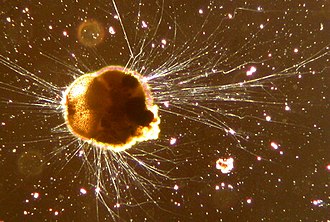Archaeplastida
Archaeplastida[edit]

Archaeplastida is a major group of eukaryotes that includes the land plants, green algae, red algae, and glaucophytes. This group is characterized by having chloroplasts that are surrounded by two membranes, which is indicative of a primary endosymbiotic event with a cyanobacterium.
Characteristics[edit]
Archaeplastida are primarily distinguished by their photosynthetic capabilities, which are facilitated by chloroplasts derived from an ancient endosymbiotic event. The chloroplasts in Archaeplastida are surrounded by two membranes, unlike those in other photosynthetic eukaryotes, which often have more membranes due to secondary endosymbiosis.
Chloroplasts[edit]
The chloroplasts of Archaeplastida contain chlorophyll a and, in some groups, chlorophyll b. The presence of these pigments allows them to capture light energy for photosynthesis. The chloroplasts are thought to have originated from a single endosymbiotic event involving a cyanobacterium.
Cell Structure[edit]
Archaeplastida cells typically have a cell wall composed of cellulose, although the composition can vary among different groups. They also possess a large central vacuole that helps maintain cell turgor and store nutrients.
Major Groups[edit]
Archaeplastida is divided into three main lineages:
Glaucophytes[edit]

Glaucophytes are a small group of freshwater algae that retain a peptidoglycan layer between the two membranes of their chloroplasts, a feature reminiscent of their cyanobacterial ancestors. This group is considered to be the most basal lineage of Archaeplastida.
Red Algae[edit]
Red algae, or Rhodophyta, are primarily marine organisms known for their reddish color, which is due to the presence of the pigment phycoerythrin. They are an important component of coral reefs and are used in various commercial applications, such as the production of agar and carrageenan.
Green Algae and Land Plants[edit]

Green algae and land plants form a clade known as Viridiplantae. Green algae are diverse and can be found in a variety of habitats, including freshwater, marine, and terrestrial environments. Land plants, or Embryophytes, evolved from a group of green algae and have colonized terrestrial environments, leading to the vast diversity of plant life seen today.
Evolutionary Significance[edit]
The Archaeplastida are significant in the study of evolution because they represent one of the earliest diverging lineages of photosynthetic eukaryotes. The primary endosymbiotic event that led to the formation of their chloroplasts is a key event in the history of life on Earth, as it enabled the rise of photosynthetic organisms that contribute to the global carbon cycle and oxygen production.
Related Pages[edit]
Gallery[edit]




Ad. Transform your life with W8MD's Budget GLP-1 injections from $75


W8MD offers a medical weight loss program to lose weight in Philadelphia. Our physician-supervised medical weight loss provides:
- Weight loss injections in NYC (generic and brand names):
- Zepbound / Mounjaro, Wegovy / Ozempic, Saxenda
- Most insurances accepted or discounted self-pay rates. We will obtain insurance prior authorizations if needed.
- Generic GLP1 weight loss injections from $75 for the starting dose.
- Also offer prescription weight loss medications including Phentermine, Qsymia, Diethylpropion, Contrave etc.
NYC weight loss doctor appointmentsNYC weight loss doctor appointments
Start your NYC weight loss journey today at our NYC medical weight loss and Philadelphia medical weight loss clinics.
- Call 718-946-5500 to lose weight in NYC or for medical weight loss in Philadelphia 215-676-2334.
- Tags:NYC medical weight loss, Philadelphia lose weight Zepbound NYC, Budget GLP1 weight loss injections, Wegovy Philadelphia, Wegovy NYC, Philadelphia medical weight loss, Brookly weight loss and Wegovy NYC
|
WikiMD's Wellness Encyclopedia |
| Let Food Be Thy Medicine Medicine Thy Food - Hippocrates |
Medical Disclaimer: WikiMD is not a substitute for professional medical advice. The information on WikiMD is provided as an information resource only, may be incorrect, outdated or misleading, and is not to be used or relied on for any diagnostic or treatment purposes. Please consult your health care provider before making any healthcare decisions or for guidance about a specific medical condition. WikiMD expressly disclaims responsibility, and shall have no liability, for any damages, loss, injury, or liability whatsoever suffered as a result of your reliance on the information contained in this site. By visiting this site you agree to the foregoing terms and conditions, which may from time to time be changed or supplemented by WikiMD. If you do not agree to the foregoing terms and conditions, you should not enter or use this site. See full disclaimer.
Credits:Most images are courtesy of Wikimedia commons, and templates, categories Wikipedia, licensed under CC BY SA or similar.
Translate this page: - East Asian
中文,
日本,
한국어,
South Asian
हिन्दी,
தமிழ்,
తెలుగు,
Urdu,
ಕನ್ನಡ,
Southeast Asian
Indonesian,
Vietnamese,
Thai,
မြန်မာဘာသာ,
বাংলা
European
español,
Deutsch,
français,
Greek,
português do Brasil,
polski,
română,
русский,
Nederlands,
norsk,
svenska,
suomi,
Italian
Middle Eastern & African
عربى,
Turkish,
Persian,
Hebrew,
Afrikaans,
isiZulu,
Kiswahili,
Other
Bulgarian,
Hungarian,
Czech,
Swedish,
മലയാളം,
मराठी,
ਪੰਜਾਬੀ,
ગુજરાતી,
Portuguese,
Ukrainian